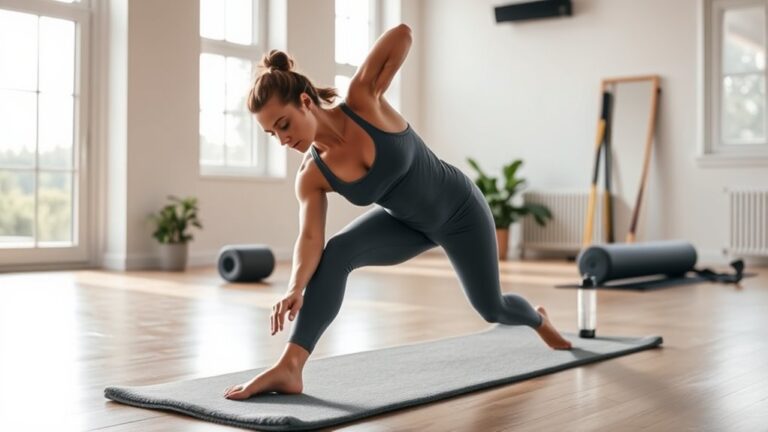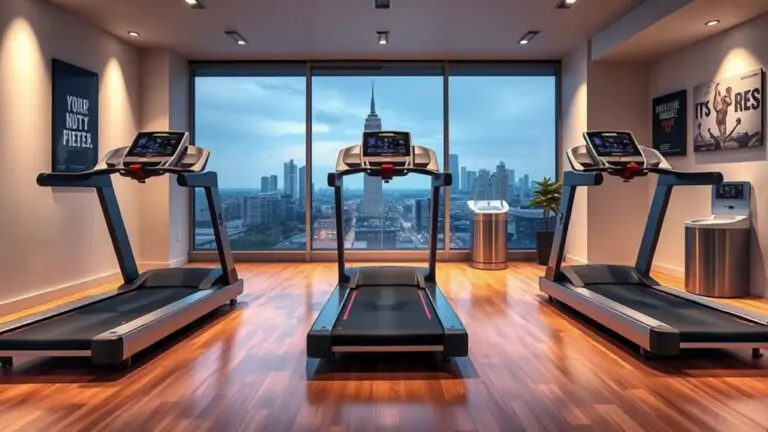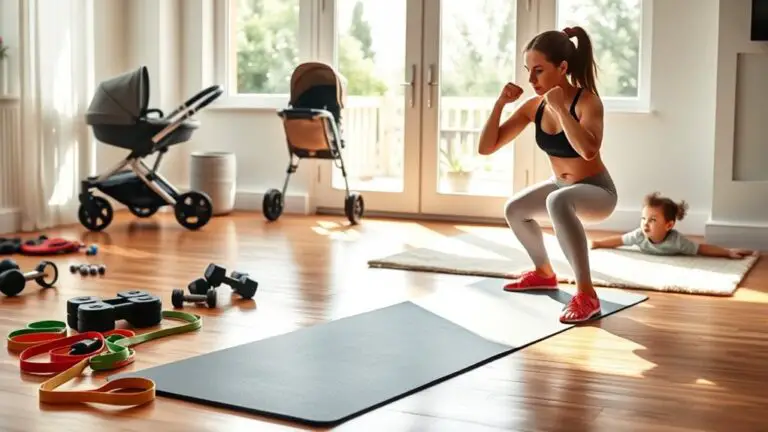How to Train for Stamina and Strength as a Chef

To train for stamina and strength as a chef, focus on a balanced workout routine that includes cardiovascular exercises, strength training, and flexibility work. Incorporate activities like running or cycling for endurance and exercises such as squats and push-ups for strength. Make sure to engage in yoga or dynamic stretches for mobility. Don’t forget about nutrition and recovery strategies to keep your energy high and prevent burnout. Discover more tips to enhance your culinary performance effectively.
Understanding the Demands of a Chef’s Role
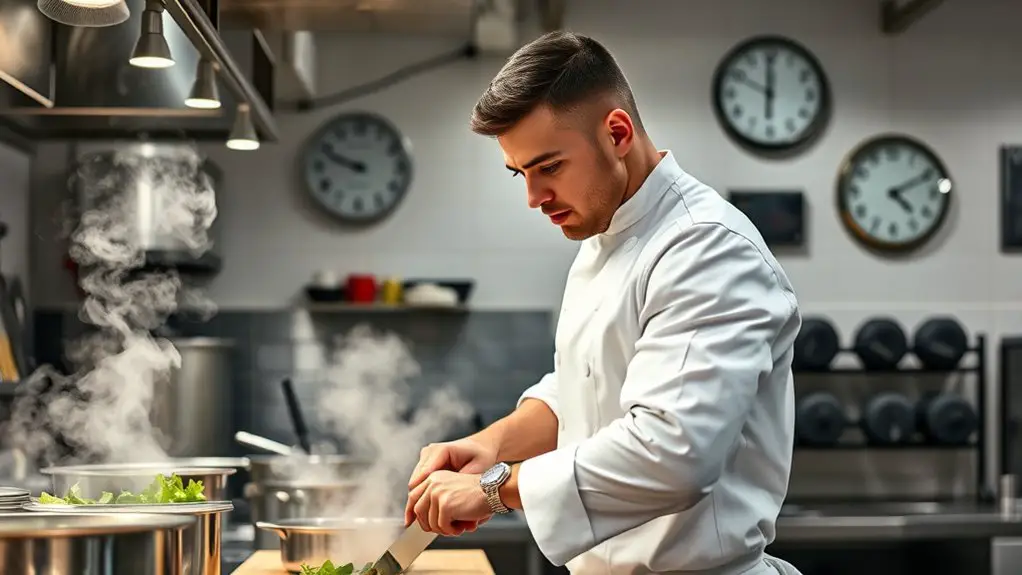
The life of a chef is a whirlwind of activity, requiring both physical and mental endurance. You’ll face a demanding culinary workload, juggling multiple tasks while maintaining precision and creativity. It’s essential to understand that your day can include long hours on your feet, heavy lifting, and quick movements, all of which put a strain on your body.
That’s where kitchen ergonomics comes into play. By setting up your workspace efficiently, you can minimize unnecessary movements and reduce the risk of injury. Positioning tools and ingredients within easy reach not only streamlines your workflow but also helps you maintain energy throughout your shift.
Embrace these demands as part of your culinary journey. Prioritizing your physical well-being and mastering kitchen ergonomics will enhance your performance and keep you thriving in the fast-paced environment of the kitchen. Remember, a well-prepared chef is a successful chef!
Importance of Stamina and Strength in the Kitchen
While you might love the art of cooking, the physical demands of working in a kitchen require both stamina and strength to truly excel. Building these attributes isn’t just about lifting heavy pots; it’s about enhancing your kitchen efficiency and culinary endurance. Here are four reasons why stamina and strength matter:
- Long Shifts: You’ll often be on your feet for hours, and stamina helps you maintain focus and energy throughout.
- Heavy Lifting: From bags of flour to large pots, strength is essential for handling kitchen equipment safely and effectively.
- Quick Movements: A strong, agile body allows you to move swiftly during peak hours, ensuring timely dish preparation.
- Stress Management: Physical fitness helps reduce fatigue, enabling you to manage the high-pressure environment of a busy kitchen.
Investing in your stamina and strength is key to a successful culinary career.
Assessing Your Current Fitness Level
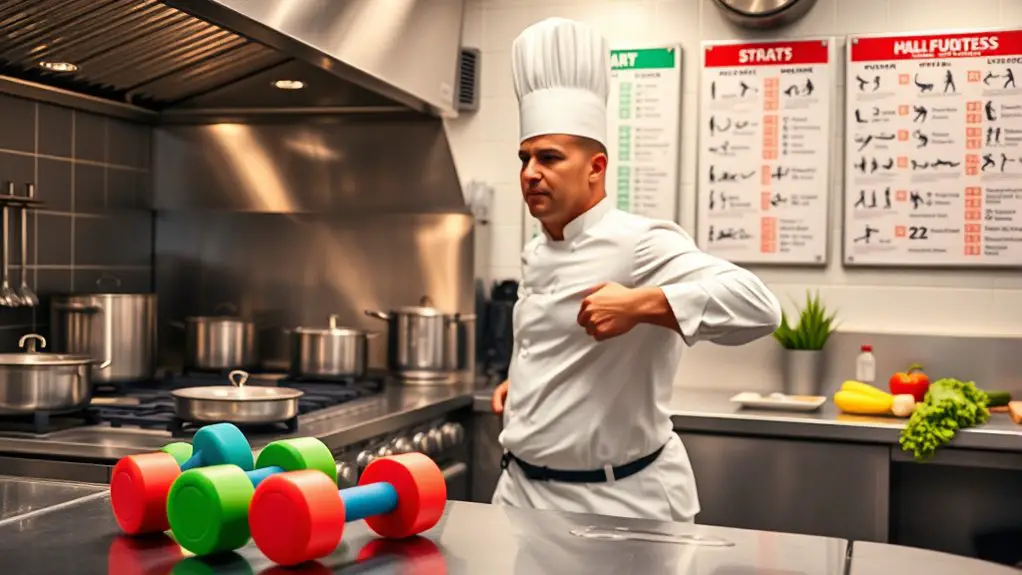
Before you can improve your stamina and strength, you need to know where you stand. Start by measuring your physical endurance and evaluating your strength capacity—this’ll give you a clear picture of your current fitness level. Once you’ve got that, you can set personal goals that will guide your training journey effectively.
Measuring Physical Endurance
How can you truly know where you stand in your fitness journey as a chef? Measuring your physical endurance is essential to track your progress and set realistic goals. Here’s how to assess your endurance metrics against performance benchmarks:
- Timed Runs: Measure how long it takes you to complete a specific distance, like 1 mile.
- Stair Climbing: Count how many flights you can climb without stopping.
- Circuit Training: Track the number of repetitions of a particular exercise, like push-ups or squats, within a set time.
- Heart Rate Recovery: Measure how quickly your heart rate returns to normal after intense activity.
Evaluating Strength Capacity
To effectively gauge your strength capacity as a chef, it’s essential to assess not just how much weight you can lift, but also how your body moves and functions under various conditions. Start with a physical assessment that includes exercises like squats, deadlifts, and push-ups. These movements reveal your overall strength and stability. Pay attention to your form; it’s not just about lifting heavy but doing so safely and efficiently. Additionally, evaluate your endurance through circuit training that mimics kitchen tasks, ensuring you can maintain strength over time. Regularly revisiting this evaluation will help you track progress and recognize areas needing improvement. Remember, knowing your current fitness level is the first step toward building your strength effectively.
Setting Personal Goals
Setting personal goals is essential for chefs looking to enhance their stamina and strength. By evaluating your current fitness level, you can create effective goal-setting strategies that align with your personal motivation. Here are four steps to help you get started:
- Evaluate Your Current Fitness: Take note of your endurance and strength levels.
- Identify Specific Areas for Improvement: Focus on stamina, strength, or both.
- Set Measurable Goals: Aim for quantifiable achievements, like running a certain distance or lifting a specific weight.
- Track Your Progress: Keep a journal to stay motivated and adjust your goals as needed.
Building a Balanced Workout Routine
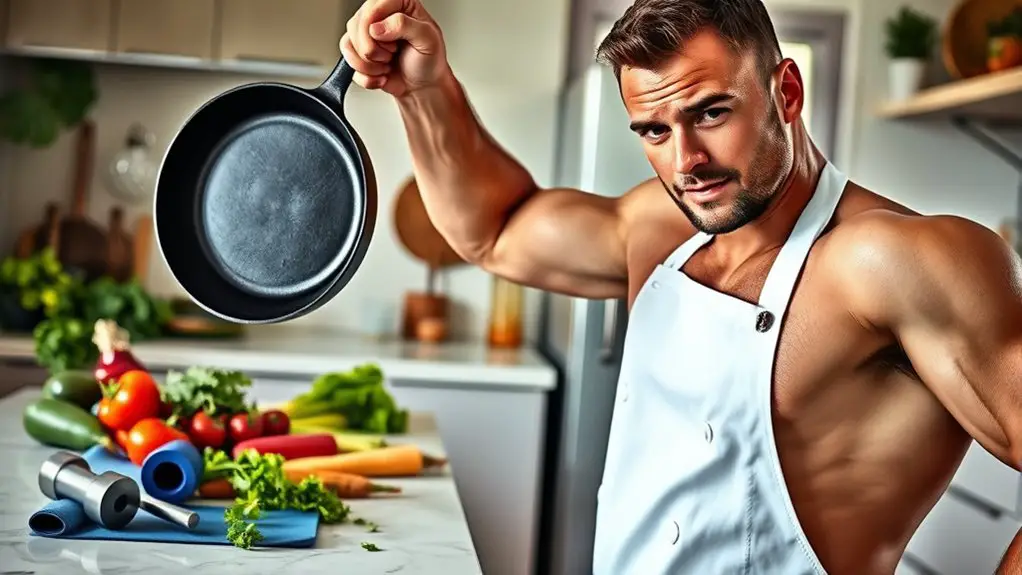
To build a balanced workout routine as a chef, you need to incorporate cardiovascular training, strength exercises, and flexibility work. Each component plays an essential role in enhancing your stamina and strength, ensuring you’re ready for the demands of the kitchen. Let’s break down how to effectively integrate these elements into your weekly regimen.
Cardiovascular Training Essentials
While you might think that strength training is the only way to build endurance in the kitchen, incorporating cardiovascular exercises into your routine is equally essential. These exercises not only boost your stamina but also improve your overall performance. Here are some key components to include:
- Aerobic exercises: Engage in activities like running or cycling to enhance your heart health.
- Cardio intervals: Alternate between high-intensity bursts and lower-intensity recovery periods for maximum efficiency.
- Dancing: Incorporate fun moves to keep your workouts enjoyable and effective.
- Swimming: A low-impact option that builds endurance without stressing your joints.
Strength Training Techniques
Building stamina through cardiovascular training lays a solid foundation for strength training, which is equally essential for chefs. To enhance your strength, you should incorporate a mix of bodyweight exercises and resistance training into your routine. Start with bodyweight exercises like push-ups, squats, and lunges to build a strong core and improve overall stability. Once you’re comfortable, add resistance training with dumbbells or resistance bands to challenge your muscles further. Aim for two to three strength sessions per week, focusing on different muscle groups each time. Remember to maintain proper form to prevent injuries, and gradually increase the intensity as you get stronger. By committing to this balanced workout routine, you’ll boost your endurance and overall performance in the kitchen.
Flexibility and Mobility Work
Incorporating flexibility and mobility work into your routine is essential for enhancing your overall performance as a chef. By focusing on these areas, you’ll improve your range of motion and prevent injuries, ensuring you can handle the demands of the kitchen. Here are four effective strategies:
- Dynamic Stretching: Start your day with movements that activate your muscles, enhancing hip flexibility and shoulder mobility.
- Yoga Benefits: Incorporate yoga sessions to boost core stability and promote postural alignment.
- Mobility Drills: Perform targeted exercises that enhance joint movement and overall mobility.
- Foam Rolling: Use foam rollers to release muscle tension, aiding recovery and improving flexibility.
Commit to these practices, and you’ll notice a significant difference in your stamina and performance!
Incorporating Cardio for Endurance
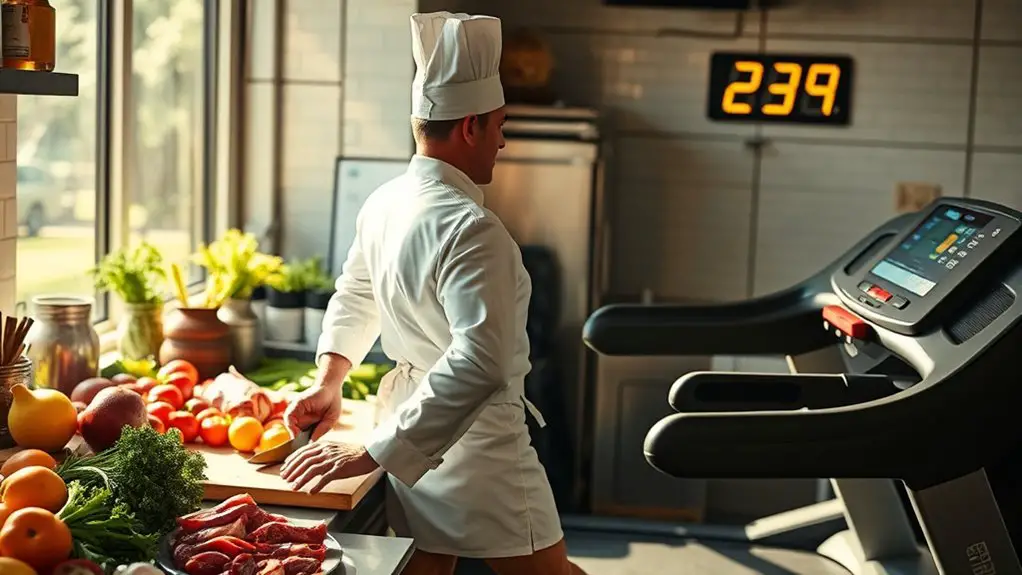
As you navigate the fast-paced world of a kitchen, adding cardio to your routine can be a game-changer for your endurance. Incorporating cardio intervals into your workouts keeps your heart rate up, mimicking the hustle of a busy shift. Aim for 20-30 minutes, mixing high-intensity bursts with low-intensity recovery periods. This method not only builds stamina but also boosts your metabolism, helping you stay sharp during long hours. Engaging in aerobic activities like running, cycling, or even brisk walking can enhance your overall fitness. Try to fit in at least three sessions a week. Remember, the goal is to improve your cardiovascular health while being mindful of your time constraints. Make it fun—listen to music or invite a fellow chef to join. By prioritizing cardio, you’ll find yourself more energized and focused, ready to tackle any culinary challenge that comes your way. Adding effective cardio workouts to your routine can greatly enhance your stamina and overall fitness.
Strength Training Exercises for Chefs
A solid strength training routine is vital for chefs who want to improve their physical resilience in the kitchen. Incorporating targeted chef exercises into your fitness plans can enhance your stamina and overall performance. Here are four effective strength routines to contemplate:
- Squats: Perfect for building leg strength, squats mimic the movements you’ll make lifting heavy pots and pans.
- Deadlifts: This resistance training exercise strengthens your back and legs, essential for lifting and moving equipment safely.
- Push-ups: A simple yet effective way to build upper body strength and endurance, perfect for those long shifts.
- Planks: Great for core stability, planks help you maintain posture while working on your feet for hours.
Flexibility and Mobility Workouts
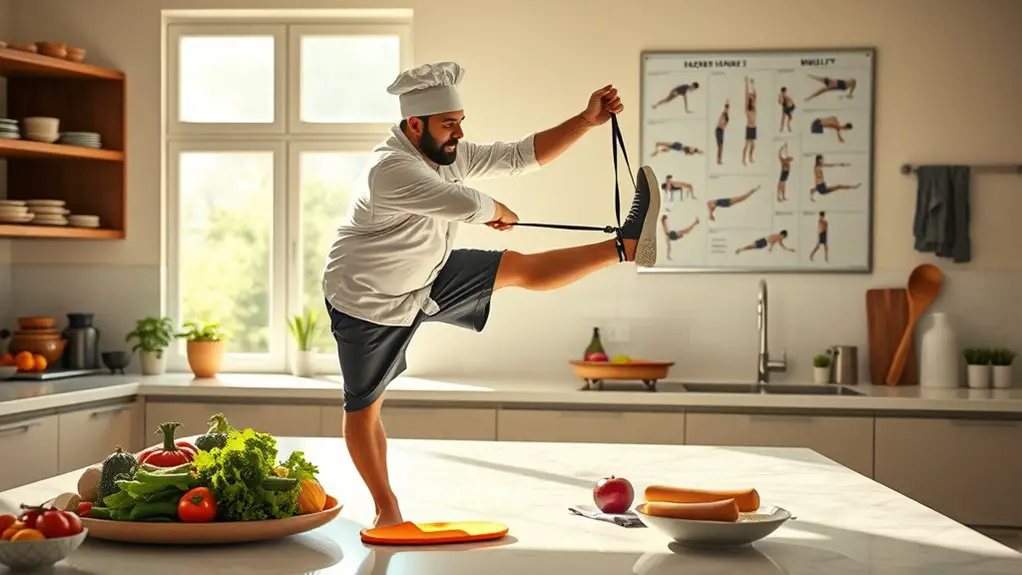
While you might think strength is all that matters in the kitchen, flexibility and mobility are equally essential for a chef’s performance. Incorporating yoga routines into your training can help improve your balance and prevent injuries. These routines not only enhance your physical flexibility but also promote mental clarity—both invaluable in a high-pressure environment.
Dynamic stretching is another critical component. Before your shifts, take a few minutes to perform dynamic stretches that target your shoulders, hips, and back. This prep work can help you move more freely while chopping, stirring, or reaching for ingredients.
Commit to a regular flexibility and mobility workout schedule, and you’ll find yourself more agile during busy service hours. Trust me, your body will thank you when you can bend, twist, and reach without discomfort. Embrace these practices, and you’ll elevate your culinary game to new heights!
Nutrition Tips for Optimal Performance
To perform at your best in the kitchen, you need to fuel your body with balanced meals that support your energy levels. Staying properly hydrated and timing your meals can make a significant difference in your stamina and strength. Let’s explore how these nutrition strategies can enhance your performance as a chef.
Balanced Meal Planning
Effective meal planning is essential for chefs who need to maintain both stamina and strength throughout long shifts in the kitchen. Prioritizing nutrient balance and incorporating ingredient variety can make all the difference. Here’s how to get started:
- Meal Prep: Prepare meals in advance to save time and guarantee you’re eating well.
- Portion Control: Keep your portions in check to avoid feeling sluggish during busy hours.
- Meal Timing: Schedule your meals and snacks to fuel your energy throughout the day.
- Dietary Preferences: Tailor your meal plans to accommodate any dietary needs, ensuring you have plenty of snack options and diverse cooking methods.
With a solid meal plan, you’ll be set for success in the kitchen!
Hydration Strategies
Staying properly hydrated is essential for chefs, especially during those hectic shifts when every minute counts. To maintain your energy and focus, implement effective hydration techniques throughout your day. Keep a refillable water bottle nearby and set reminders to sip consistently, aiming for ideal fluid intake. Consider incorporating electrolyte-rich drinks if you’re sweating heavily or working longer hours. Remember, hydration isn’t just about water; nutrient-packed smoothies or coconut water can provide a revitalizing boost. Also, pay attention to your body’s signals—if you’re feeling fatigued or lightheaded, it’s time to hydrate. By prioritizing your hydration, you’ll enhance your stamina and strength, allowing you to perform at your best in the kitchen. Stay sharp, stay hydrated!
Timing of Meals
Hydration is just the beginning when it comes to fueling your performance in the kitchen. Proper meal timing is essential for maintaining energy levels throughout your shift. Here are some strategies to enhance your nutrition:
- Pre-shift nutrition: Eat a balanced meal rich in protein and complex carbs to sustain energy.
- Snack strategies: Incorporate energy-boosting foods like nuts and fruit during breaks to keep your stamina up.
- Meal prep efficiency: Prepare meals ahead of time to avoid last-minute unhealthy choices.
- Post-shift recovery: Focus on replenishing with protein and carbs to aid recovery after a long day.
Recovery Strategies to Prevent Burnout
Although the fast-paced kitchen environment can be exhilarating, it’s essential to prioritize recovery strategies to prevent burnout. To maintain your energy and passion, incorporate mindfulness practices into your daily routine. Start by taking a few minutes each shift to focus on your breath, grounding yourself in the present moment. This simple act can greatly reduce stress and enhance your overall well-being.
Additionally, set aside time for restorative activities outside the kitchen. Whether it’s yoga, meditation, or a quiet walk, these practices can help you recharge mentally and physically. Don’t underestimate the power of proper sleep; aim for a consistent sleep schedule to guarantee your body recovers fully.
Lastly, communicate with your team about workload and stress management. Sharing your experiences fosters a supportive environment where everyone can thrive, reducing the risk of burnout and keeping your passion for culinary arts alive.
Setting Realistic Fitness Goals for Culinary Success
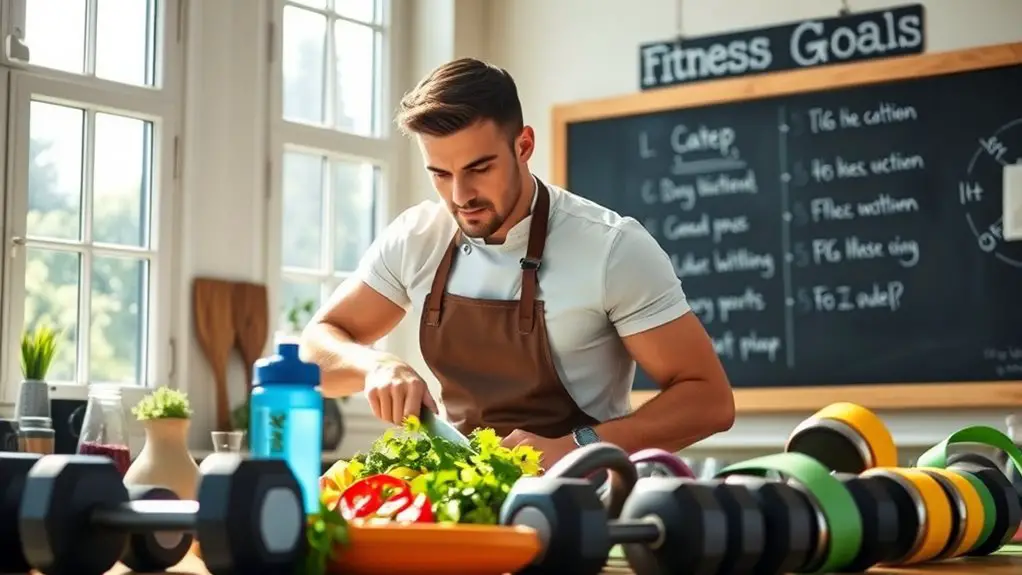
When you’re juggling the demands of a busy kitchen, setting realistic fitness goals can make all the difference in maintaining your stamina and strength. Here’s how to effectively approach goal setting for culinary success:
- Define Clear Objectives: Identify specific areas you want to improve, like endurance or core strength.
- Break It Down: Divide larger goals into smaller, achievable milestones to keep you motivated.
- Create a Routine: Establish a consistent workout schedule that fits into your kitchen life, ensuring it’s manageable.
- Track Your Progress: Use a journal or app to monitor your improvements. This helps keep you accountable and allows for adjustments as needed. Remember that signs of progress can include increased strength and improved energy levels, which are vital for your demanding work environment.
Frequently Asked Questions
How Can I Motivate Myself to Stick to This Training Routine?
To motivate yourself to stick to your training routine, start with clear goal setting. Break down your larger goals into manageable milestones that you can celebrate along the way. Consider finding an accountability partner who shares similar fitness aspirations; they can help keep you on track and provide support. Remember, consistency is key, and surrounding yourself with positive influences can make all the difference in staying committed to your fitness journey.
What Are the Best Warm-Up Exercises Before a Shift?
Before your shift, it’s essential to get your body ready. Start with dynamic stretches like arm circles and leg swings to loosen up your muscles. Follow this with mobility drills, such as hip openers and ankle rolls, to improve your range of motion. These exercises not only prepare you physically but also help prevent injuries. By investing just a few minutes in warm-ups, you’re setting yourself up for a successful and energized shift ahead!
Can I Train at Home Without Special Equipment?
When it comes to training at home, you can definitely make a splash without fancy equipment. You’ll find that bodyweight exercises, like push-ups and squats, can work wonders for building strength. Don’t forget to throw in some kitchen stretches to keep your muscles flexible and ready for action. So, roll up your sleeves and get moving; you’ve got everything you need to whip up a solid workout right in your own space!
How Do I Balance Work and Training Schedules Effectively?
Balancing work and training schedules effectively requires smart time management and some schedule flexibility. Start by blocking out specific times for training in your calendar, treating them as non-negotiable appointments. Listen to your body; if you’re too fatigued, adjust your routine. Incorporate short, intense workouts if you’re pressed for time, and don’t forget to prioritize rest. With a solid plan, you’ll find it easier to stay committed to both your job and fitness goals.
What Are Common Injuries Chefs Face, and How Can I Prevent Them?
Did you know that over 60% of chefs experience work-related injuries? To prevent these, focus on kitchen ergonomics—adjust your workspace and tools to reduce strain. Use proper lifting techniques and take regular breaks to stretch. Invest in supportive footwear to keep your feet comfortable. Staying aware of your body and recognizing signs of fatigue can also help in injury prevention. Remember, a healthy chef is a productive chef!
